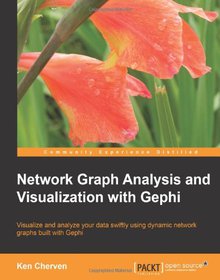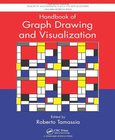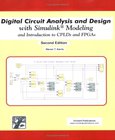Network Graph Analysis and Visualization with Gephi

Book Details:
| Publisher: | Packt Publishing |
| Series: | Packt |
| Author: | Ken Cherven |
| Edition: | 1 |
| ISBN-10: | 1783280131 |
| ISBN-13: | 9781783280131 |
| Pages: | 116 |
| Published: | Sep 24 2013 |
| Posted: | Nov 19 2014 |
| Language: | English |
| Book format: | |
| Book size: | 8.51 MB |
Book Description:
Visualize and analyze your data swiftly using dynamic network graphs built with Gephi Overview Use your own data to create network graphs displaying complex relationships between several types of data elements Learn about nodes and edges, and customize your graphs using size, color, and weight attributes Filter your graphs to focus on the key information you need to see and publish your network graphs to the Web In Detail Gephi is an interactive visualization and exploration platform for all kinds of networks and complex systems. Social media data has helped to drive network visualization to new levels of relevance and importance. However, there is far more to network visualization than just social media data. For analyzing and visualizing network graphs, you need to have an excellent platform, and you need to know ways to use your data effectively. Network Graph Analysis and Visualization with Gephi is a practical, hands-on guide that provides you with all the tools you need to begin creating your own network graphs. You will learn how to import data, test multiple graph layouts, and publish your visualizations to the Web. Network Graph Analysis and Visualization with Gephi will teach you how to create your own network graphs using Gephi. The book begins by taking you through the installation of Gephi and configuring the installation options. You will also get acquainted with the Gephi workspace and the various tools in Gephi. Next, you'll use these tools to create your own graphs. If you need to add more capability to your personal toolkit, you will be learning to Download and install several of the best Gephi layout plugins. You will then use these layouts simultaneously to produce beautiful graphs. Also, you create and import data in Gephi and add some new plugins that extend Gephi even further. You also gain the skills to prepare and customize your network visualization for export. By the end of this book, you will be able to create your own network graphs using Gephi, customize the look and feel of your graphs, and successfully publish them to the Web. What you will learn from this book Install and configure Gephi on your computer and navigate around the Gephi user interface Create simple graphs using existing data and customize nodes and edges using toolbar functions Learn about the use of installed layout formats as well as how to install and use additional layouts via plugins Create data sources internally with spreadsheets and MySQL and filter data within your network graphs Install additional plugins to enhance Gephi's base functionality Use statistics, ranking, and querying to learn more about your data Customize and deploy your graphs to the Web and find additional resources on network graphs and visualizations Approach A practical, hands-on guide, that provides you with all the tools you need to visualize and analyze your data using network graphs with Gephi. Who this book is written for This book is for data analysts who want to intuitively reveal patterns and trends, highlight outliers, and tell stories with their data using Gephi. It is great for anyone looking to explore interactions within network datasets, whether the data comes from social media or elsewhere. It is also a valuable resource for those seeking to learn more about Gephi without being overwhelmed by technical details.
Download Link:
Related Books:
Handbook of Graph Drawing and Visualization
Get an In-Depth Understanding of Graph Drawing Techniques, Algorithms, Software, and Applications The Handbook of Graph Drawing and Visualization provides a broad, up-to-date survey of the field of graph drawing. It covers topological and geometric foundations, algorithms, software systems, and visualization applications in business, education, science, and engineering. Each chapter is self-contained and includes extensive references. The first several chapters of the book deal with fundamental topological and geometric concepts and techniques used in graph drawing, such as planarity testing and embedding, crossings and planarization, symmetric drawings, and proximity drawings. The following chapters present a large collection of algorithms for con...
Mapping and Visualization with SuperCollider
Create interactive and responsive audio-visual applications with SuperCollider Overview Master 2D computer-generated graphics and animation Perform complex encodings and audio/data analysis Implement intelligent generative audio-visual systems In Detail SuperCollider is an environment and programming language used by musicians, scientists, and artists who work with audio-files SuperCollider has built-in graphical features which are used in conjunction with the sound synthesis server to create audio-visual mapping and sound visualization. If you wish to create data visualizations by acquiring data from audio and visual sources, then this book is for you. Digital sound artists need to analyze, manipulate, map, and visualize data when working on...
Digital Circuit Analysis and Design
With Simulink Modeling and Introduction to CPLDs and FPGAs
2nd Edition
This text includes the following chapters and appendices: Common Number Systems and Conversions, Operations in Binary, Octal, and Hexadecimal Systems, Sign Magnitude and Floating Point Arithmetic, Binary Codes, Fundamentals of Boolean Algebra, Minterms and Maxterms, Combinational Logic Circuits, Sequential Logic Circuits, Memory Devices, Advanced Arithmetic and Logic Operations, Introduction to Field Programmable Devices, Introduction to the ABEL Hardware Description Language, Introduction to VHDL, Introduction to Verilog, and Introduction to Boundary-Scan Architecture. Each chapter contains numerous practical applications. This is a design-oriented te...
2007 - 2021 © eBooks-IT.org



